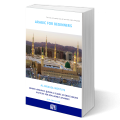
The plural in Arabic - الْجَمْعُ
Introduction
In Arabic, plurals are categorized into two distinct types:
Sound plural – اَلْجَمْعُ السَّالِمُ
Broken plural: اَلْجَمْعُ الْمُكَسَّرُ
A. The sound Plural - اَلْجَمْعُ السَّالِمُ
The Masculine Sound Plural
In Arabic, the sound plural stands out for its regularity and simplicity. Unlike other plural forms, the core structure of the noun remains consistent when converting to its sound plural form. This method showcases the innate fluidity and structure of the Arabic language.
-
Masculine Formation: For masculine nouns, the sound plural takes on specific suffixes, distinguished by the case in which they are used:
a. Nominative Case: The masculine noun in the nominative embraces the suffix pattern of a dammah, followed by a waw with a sukoon, and concluding with a noon bearing a fatha:
- ـوْنَ
b. Accusative and Genitive Cases: In these cases, the suffix transitions into a kasra, succeeded by a yaa with a sukoon, and ending with a noon adorned with a fatha:
- ـيْنَ
It’s vital to recognize the linguistic case of the masculine noun to ensure the appropriate sound plural suffix is utilized, capturing the essence and eloquence of the Arabic plural form.
Examples:
Nominative case
Singular
مُسْلِمٌ
a muslim
Dual
مُسْلِمَانِ
two muslims
Plural
مُسلِمُوْنَ
Des musulmans
Accusative case
Singular
مُسْلِمًا
A muslim
Dual
مُسْلِمِيْنَ
Two muslims
Plural
مُسْلِمِيْنَ
Muslims
Genitive case
Singular
مُسْلِمٍ
A Muslim
Dual
مُسْلِمِيْنَ
Two muslims
Plural
مُسْلِمِيْنَ
Muslims
Feminine sound plural
In Arabic, the sound plural form for feminine nouns demonstrates a harmonious blend of suffixes, adapting according to the case:
-
Feminine Formation:
a. Nominative Case: When dealing with the nominative, a fatha followed by an alif, and culminating with a taa accompanied by tanween dammah is suffixed:
- ـاتٌ
b. Accusative and Genitive Cases: In these contexts, the suffix incorporates a fatha, succeeded by an alif, and concludes with a taa that carries tanween kasrah:
- ـاتٍ
The meticulous application of these suffixes in feminine plurals illuminates the depth and structure of Arabic grammar.
Here are some illustrative examples to further elucidate this principle:
Nominative case:
Singular
مُسْلِمَةٌ
a muslim woman
Dual
مُسْلِمَتانِ
Two muslim women
Plural
مُسْلِماتٌ
Muslim women
Accusative case:
Singular
مُسْلِمَةً
Muslim woman
Dual
مُسْلِمَتَيْنِ
Two Muslim
Plural
مُسْلِماتٍ
Muslim women
Genetive case:
Singular
مُسْلِمَةٍ
Muslim woman
Plural
مُسْلِماتٍ
Muslim women
In Arabic, the intricate dance of short vowels and specific endings distinctly delineates grammatical cases, even in their simplest forms. This becomes particularly evident when examining the singular, dual, and plural forms of nouns.
Singular Form and Its Cases: In the singular format, the cases – nominative, accusative, and genitive – are primarily distinguished by the harakat, or the short vowel marks, appended to the last letter:
-
Nominative Case: Characterized by tanwin dammah: مُسْلِمٌ (-ٌ)
-
Accusative Case: Denoted by tanwin fatha: مُسْلِمًا (-ً)
-
Genitive Case: Signified by tanween kasrah: مُسْلِمٍ (-ٍ)
Dual and Plural Forms: As we progress to the dual and plural forms, the depiction of grammatical cases (known as i’rab or الإِعْرَابُ) evolves. Rather than relying solely on harakat, these forms employ a combination of letters and harakat to convey the nominative, accusative, and genitive cases. Such markers include:
- ـوْنَ
- ـيْنَ
- ـانِ
- وْنَ
- يْنَ
By understanding and accurately applying these markers, readers and speakers can aptly navigate the linguistic landscape of Arabic, ensuring clear communication and a deep appreciation for the language’s grammatical intricacies.
Illustration from the Noble Quran:
إِنَّ الْمُسْلِمِينَ وَالْمُسْلِمَاتِ وَالْمُؤْمِنِينَ وَالْمُؤْمِنَاتِ وَالْقَانِتِينَ وَالْقَانِتَاتِ وَالصَّادِقِينَ وَالصَّادِقَاتِ وَالصَّابِرِينَ وَالصَّابِرَاتِ وَالْخَاشِعِينَ وَالْخَاشِعَاتِ وَالْمُتَصَدِّقِينَ وَالْمُتَصَدِّقَاتِ وَالصَّائِمِينَ وَالصَّائِمَاتِ وَالْحَافِظِينَ فُرُوجَهُمْ وَالْحَافِظَاتِ وَالذَّاكِرِينَ اللَّـهَ كَثِيرًا وَالذَّاكِرَاتِ أَعَدَّ اللَّـهُ لَهُم مَّغْفِرَةً وَأَجْرًا عَظِيمًا
B. The broken plural - اَلْجَمْعُ الْمُكَسَّرُ
In the vast tapestry of Arabic plurals, two primary forms emerge: sound plurals and broken plurals. While sound plurals maintain the core integrity of the original word, broken plurals introduce a fascinating transformation.
Sound Plurals: As mentioned, sound plurals stay true to the word’s root by merely adding specific suffixes without altering its intrinsic structure.
Broken Plurals: On the other hand, broken plurals are a testament to the dynamism of the Arabic language. Rather than just appending suffixes, broken plurals involve a more intricate process. This entails:
- Internal Morphological Alterations: The basic structure or pattern of the noun undergoes change.
- Deletions: Sometimes, certain letters or sounds from the original noun are omitted.
- Addition of Prefixes: At times, letters or sounds are prefixed to the original noun.
- Addition of Suffixes: Similar to sound plurals, but often combined with other changes.
This inherent flexibility and adaptability of broken plurals showcase the rich morphological features of the Arabic language, allowing for a single word to be expressed in a multitude of forms, each carrying its unique nuance and resonance.
Illustrative examples for the broken plurals derived from the word "book" - كِتَابٌ include:
Nominative case:
Singular
كِتَابٌ
Book
Dual
كِتَابَانِ
Two books
Plural
كُتُبٌ
Books
Accusative case:
Singular
كِتَابًا
Book
Dual
كِتابَيْنِ
Two books
Plural
كُتُبًا
Books
Genitive case:
Singular
كِتَابٍ
Book
Dual
كِتابَيْنِ
Two books
Plural
كُتُبٍ
Books
Examples of Broken Plurals:
In Arabic linguistics, one observes a fascinating overlap: the structure of the dual form often mirrors that of the sound plural across the nominative, accusative, and genitive cases.
Dual vs. Sound Plural: The dual form typically adopts a standard suffix pattern, reflecting simplicity and duality. Meanwhile, the sound plural also follows a predictable suffix addition, maintaining the core of the word, making it easily recognizable across different grammatical cases.
Transitioning to another intricate facet of Arabic morphology, let’s delve into the realm of broken plurals.
Examples of Broken Plurals: Distinct from both the dual and sound plural forms, broken plurals involve morphological adjustments that transform the original word’s internal structure. Instead of relying on consistent suffixes, broken plurals often involve alterations that can encompass deletions, prefixes, and varying suffixes, showcasing the dynamism and depth of the Arabic language.
Here are some illustrative examples of such plurals:
|
Singular مُفْرَد |
Plural جَمْع |
| وَلَدٌ | أَوْلادٌ |
| Boy | Boys |
| رَبٌّ | أَرْبَابٌ |
| Lord | Lords |
| مَالٌ | أَمْوَالٌ |
| Property | Properties |
| نَهْرٌ | أَنْهَارٌ |
| River | Rivers |
| زَوجٌ | أَزْواجٌ |
| Wife | Wives |
| رِجْلٌ | أَرْجُلٌ |
| Foot | Feet |
| عَيْنٌ | عُيُوْنٌ |
| Eye | Eyes |
| سَيْفٌ | سُيُوْفٌ |
| Sword | Swords |
| رَجُلٌ | رِجَالٌ |
| Man | Men |
| اِمْرَءَةٌ | نِسَاءٌ |
| Woman | Women |
| أَمْرٌ | أُمُورٌ |
| Command/affair | Commands/affairs |
| نَبِيٌّ | أَنْبِيَاءٌ |
| Prophet | Prophets |
| رُوْحٌ | أَرْوَاحٌ |
| Soul | Souls |
| شَهْرٌ | شُهُورٌ |
| Month | Months |
| مَدِيْنَةٌ | مُدُنٌ |
| City | Cities |
| سَفِينَةٌ | سُفُنٌ |
| Ship | Ships |
| قَلْبٌ | قُلُوْبٌ |
| Heart | Hearts |
| جَبَلٌ | جِبَالٌ |
| Mountain | Mountains |
| بَيْتٌ | بُيُوْتٌ |
| House | Houses |
| قَلَمٌ | أَقْلَامٌ |
| Pen | Pens |
Illustrations from the Noble Quran:
| وَتِلْكَ الْأَيَّامُ نُدَاوِلُهَا بَيْنَ النَّاسِ |
| And these days [of varying conditions] We alternate among the people (3:140) |
| وَجَنَّاتٌ تَجْرِي مِن تَحْتِهَا الْأَنْهَارُ |
| And gardens beneath which rivers flow [in Paradise] (3:136) |
| أَأَرْبَابٌ مُّتَفَرِّقُونَ خَيْرٌ أَمِ اللَّـهُ الْوَاحِدُ الْقَهَّارُ |
|
are separate lords better or Allah, the One, the Prevailing? (12:39) |
| وَالْجِبَالَ أَوْتَادًا |
| And the mountains as stakes? (78:7) |
| لَهُمْ قُلُوبٌ لَّا يَفْقَهُونَ بِهَا |
| They have hearts with which they do not understand (7:179) |
| فَانكِحُوا مَا طَابَ لَكُم مِّنَ النِّسَاءِ |
| then marry those that please you of [other] women (4:3) |
Conclusion
This lesson on Arabic nuances concludes here. Insha’Allah, our subsequent session will delve into the pronouns in Arabic.
Al-dirassa Institute invites you on a linguistic journey with our expert teachers to master the Arabic language. Should you wish to further your studies, we welcome your inquiries.
Chosen and Trusted by Thousands of Satisfied Learners
Discover the experiences of our delighted clients who have thoroughly enjoyed utilizing this standout feature.
Alhamdulillah I‘m very pleased with the arabic and Qur’an lessons I receive from teacher Umm Tasneem and I‘m also content with the al-dirassa administration team who were very quick in answering any questions I had. In a month I progressed a lot and I cannot wait to continue my studies with al-dirassa. May Allah reward everyone at al-dirassa.
 Verified review - view original
Verified review - view original
My Qur’an teacher is fantastic, she teaches me in a loving and kind way where I look forward to the lessons and learn so much. My Arabic teacher is equally as nice and has a lot of patience with me, she has great expertise in the field and I’ve progressed really quickly with her. Thank you Al-dirassa!
 Verified review - view original
Verified review - view original
Book your free trial lesson
Don’t want to go through the translation anymore?
30 free minutes with your qualified Egyptian teacher.




